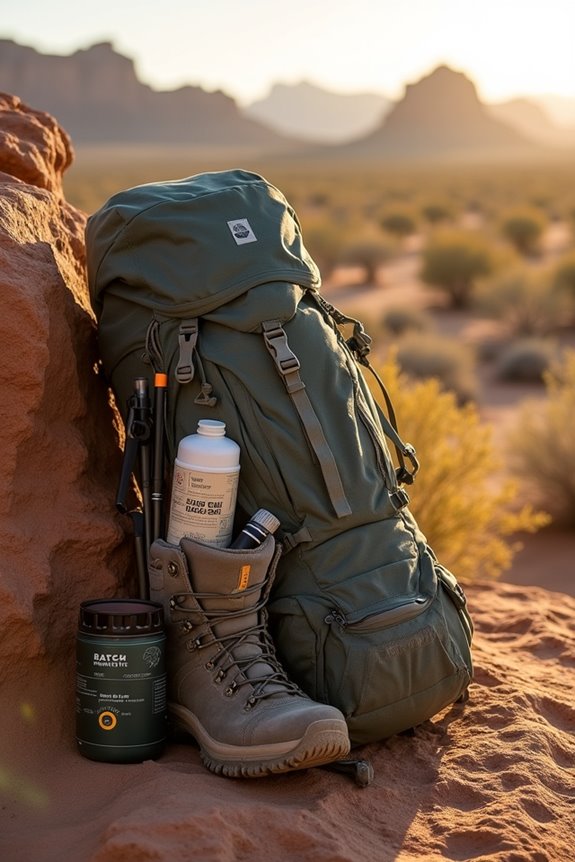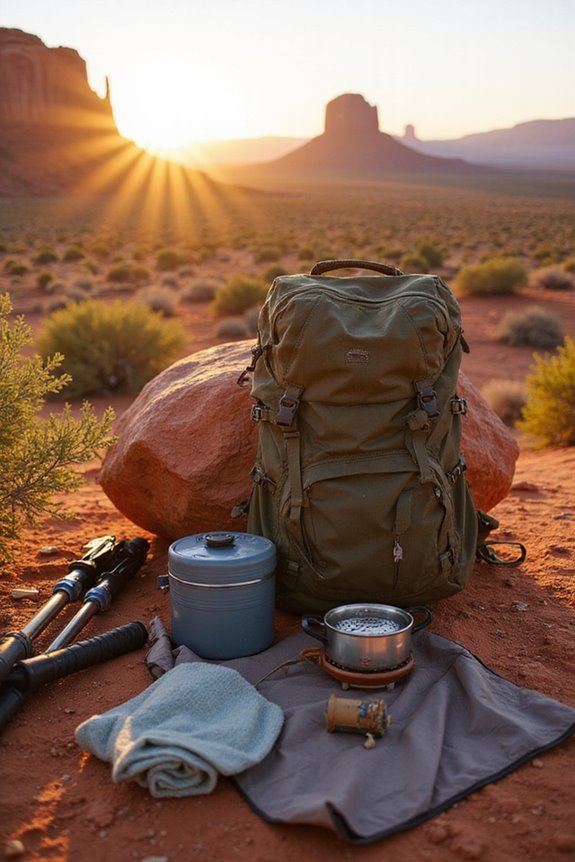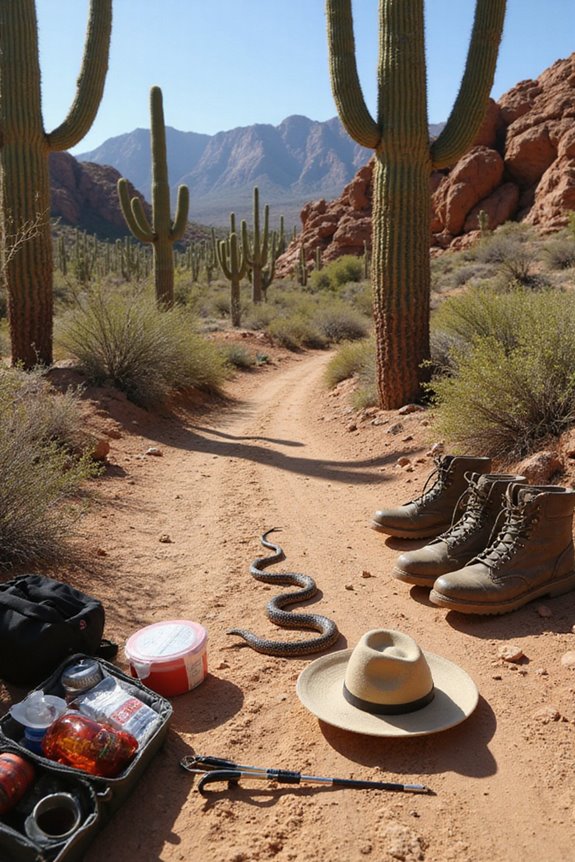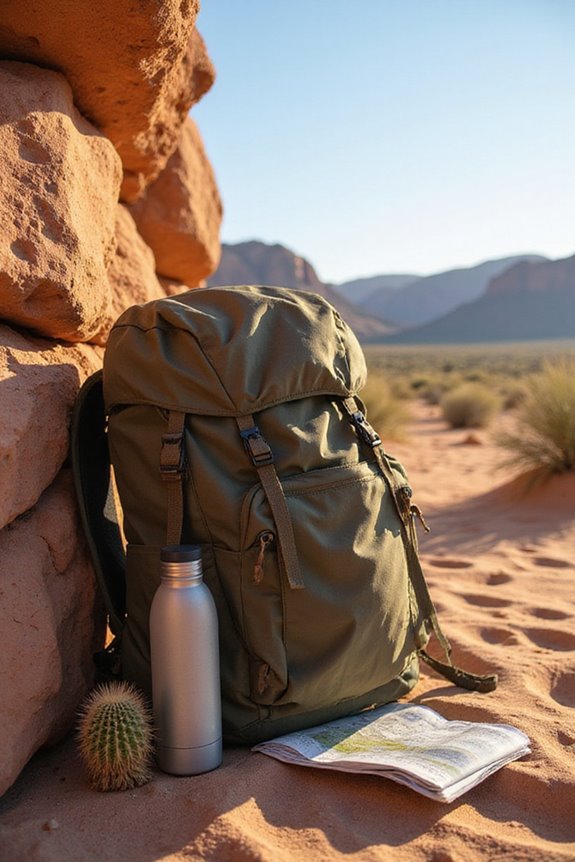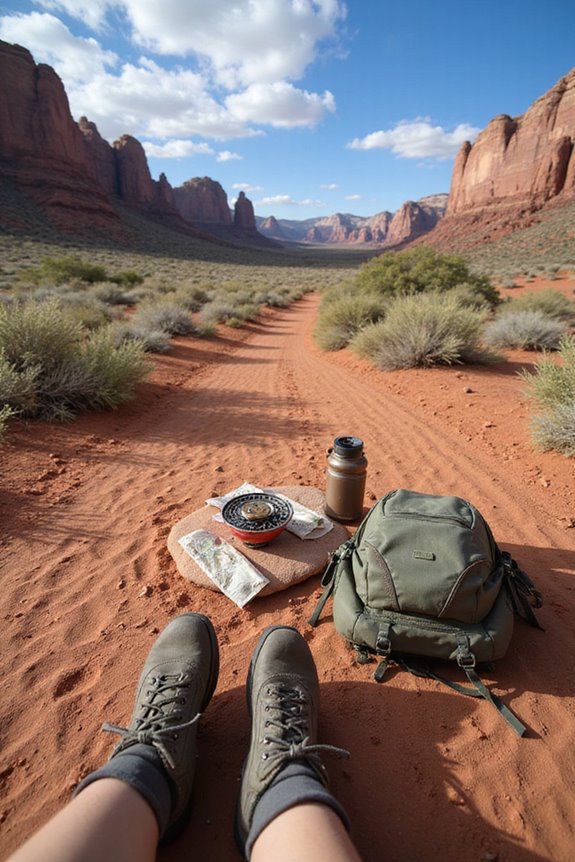When we head into the desert, packing with a Leave No Trace mindset is essential! We must bring a WAG bag for waste, ensuring we pack out everything we pack in, including food scraps and used toilet paper—no one likes an unwelcome surprise on the trail! Remember to carry lots of water and nutrient-dense snacks to keep our energy up. And don’t forget sun protection gear to shield us from those blazing rays! Ready to explore more essentials?
Key Takeaways
- Bring a specialized Pack Out Kit (WAG Bag) for proper waste disposal and management in the desert environment.
- Include inner bags for waste, toilet paper, and deodorizing powder to minimize odor and contamination.
- Always dig catholes for quick stops, ensuring waste is buried at least 200 feet from water sources.
- Pack out all food scraps and used toilet paper to leave the trail clean and undisturbed.
- Commit to preserving the desert’s pristine condition by adhering to leave no trace principles during your hike.
Essential Sun Protection Gear
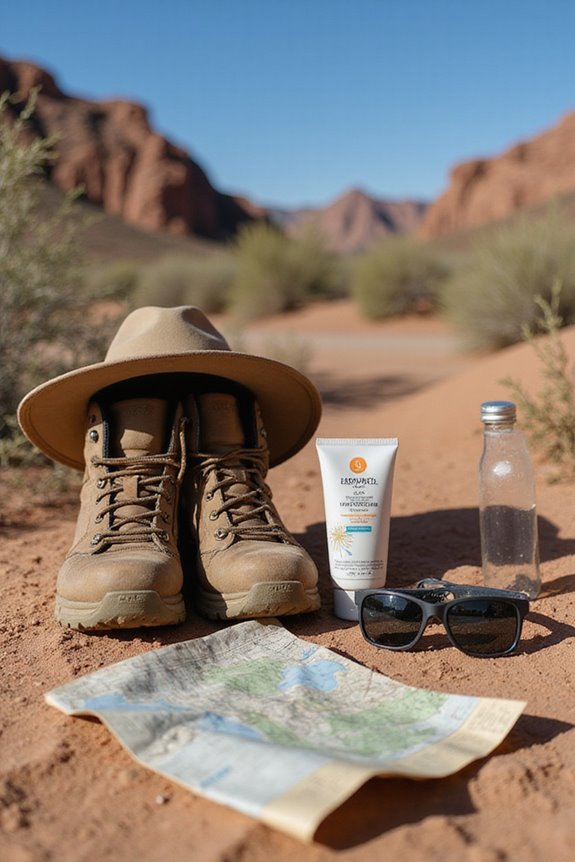
When we hit the trails, nothing’s more thrilling than basking in the great outdoors — but let’s be real, folks: the sun can be a sneaky adversary! For sun safety, we need to gear up with essential protective clothing. A wide-brimmed hat with a UPF of 50 or more? Absolutely! It’ll shield our faces and necks from scorching rays, and that adjustable chin strap keeps it secure during windy adventures. Don’t forget those UV-blocking sunglasses—wrap-around styles are our friends, guarding those peepers against dazzling reflections. Let’s add lightweight, breathable long sleeves or pants that let our skin breathe while blocking harmful rays. Look for hats with mesh panels to enhance ventilation and cooling during those sweltering desert hikes. Together, we’ll conquer the trails, looking cool and staying protected—because who wants to battle sunburn on their epic adventures?
Comfortable Footwear and Clothing
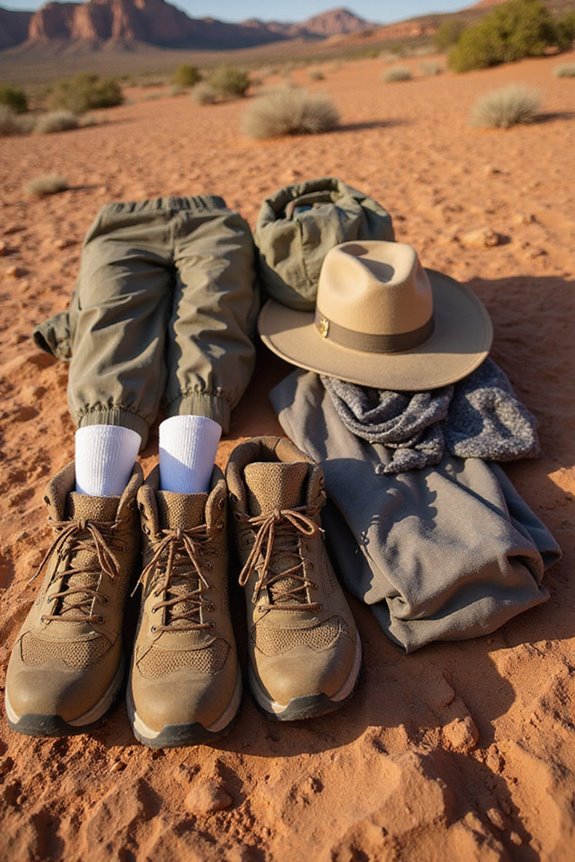
Ready to hit the trails in comfort? Let’s talk about our footwear and clothing choices! Opt for lightweight hiking shoes or mid-height boots with breathable footwear materials. Mesh panels keep our feet cool and dry while providing the ankle support we need on rocky terrain. Don’t forget cushioned midsoles—those treat our feet right during long hikes!
Layer up with light-colored, loose-fitting clothing that wicks moisture. Long sleeves and pants protect us from the sun while allowing airflow. Quick-drying synthetic fabrics beat cotton any day in the desert heat! Remember, we can adapt to changing temps with the right clothing layers. Trust me, there’s nothing worse than chafing when we’re out seeking that freedom in nature! Let’s step out in style and comfort! For desert hiking specifically, look for boots with deep lugs pattern that provide enhanced stability during descents on sandy or loose terrain.
Navigation and Safety Equipment
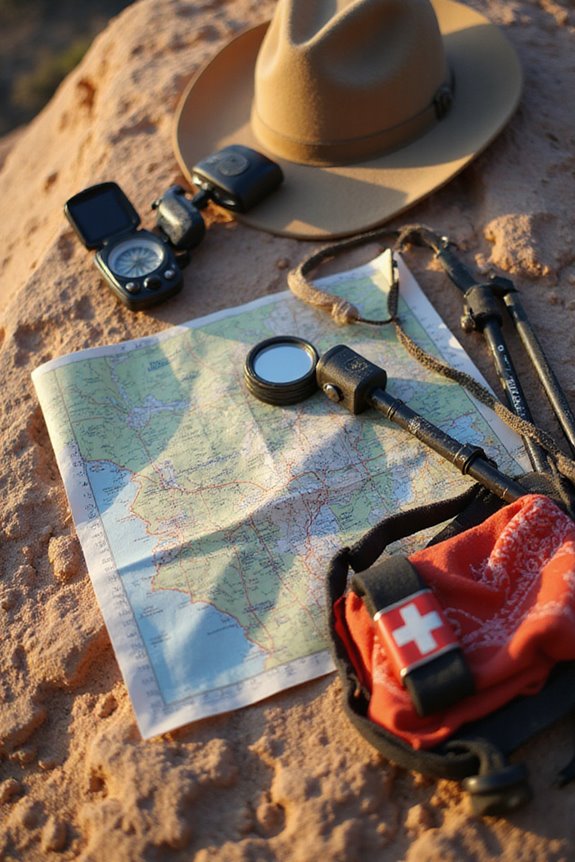
Exploring the great outdoors can be exhilarating, especially when we’re equipped with the right tools! First, we should pack essential navigation tools like a detailed topographic map in a waterproof case and a reliable compass. Trust me, knowing how to use these makes a world of difference! A GPS can be handy, but let’s not forget those trusty safety devices. Personal locator beacons (PLBs) can be true lifesavers when we wander beyond cell service. Many modern PLBs like the ACR ResQLink 400 feature GPS tracking capabilities and can send powerful distress signals for quick rescue operations. Oh, and don’t rely solely on cell phones—electronics have their moods out here! A whistle? Sure—it’s great for getting attention if we lose our way. Let’s keep our adventures safe and smart, friends. Embrace the freedom, but let’s stay prepared!
Hydration and Nutritional Needs
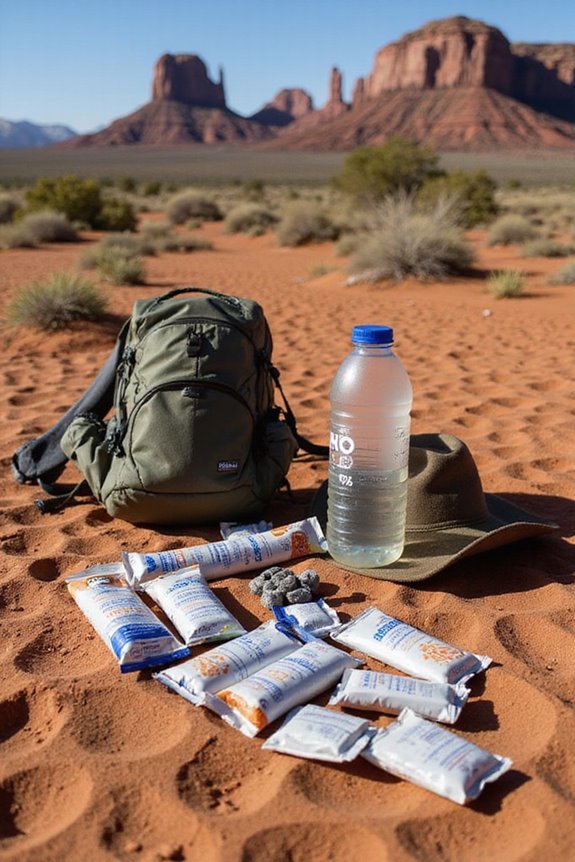
Staying hydrated and nourished is essential for any outdoor adventure, especially when we’re trekking through challenging environments like deserts. We need at least 3-4 liters of water daily, so let’s utilize hydration strategies like bladders for easy access and sturdy bottles for backup.
Don’t forget electrolyte tablets or coconut water in our packs to replace what we lose while sweating—we want to stay energized, not depleted! When choosing snacks, let’s go for lightweight, nutrient-dense options that also hydrate us, like dried fruits. Consider packing electrolyte powder mixes that contain essential minerals like sodium, potassium, magnesium, and calcium in a ratio of approximately 2:1 sodium-to-potassium for optimal hydration during desert adventures.
Appropriate Shelter and Sleeping Gear
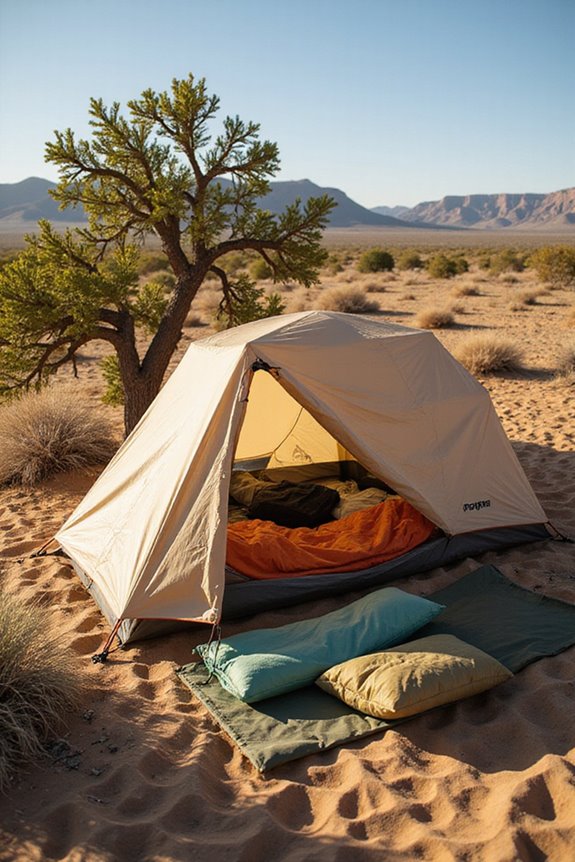
When it comes to our desert adventure, choosing the right shelter and sleeping gear is like finding the perfect dance partner—it makes or breaks our whole experience! We’ve got to go for lightweight, compact shelters that won’t crumble under the desert sun. Free-standing tents are our best bet, blending into the breathtaking landscape while minimizing damage. Look for tents with high waterproof ratings of at least 3000mm to protect against unexpected desert rain showers. For sleeping arrangements, let’s grab sleeping pads to stay cozy on that chilly desert ground and bring sleeping bags rated for those wild temperature swings. A low-profile design? Yes, please! We want to pack easily and keep our camps just as pristine as we found them. Remember, every piece of gear’s got to be quick to set up and easy to carry, folks! Let’s keep the desert wild!
Leave No Trace and Waste Management Supplies
Packing for our next outdoor adventure isn’t just about gear; it’s also about how we handle our waste! We’ve gotta think about waste disposal and sanitation supplies, folks. A specialized Pack Out Kit, or “WAG Bag,” is a must-have. It keeps things tidy with inner bags for waste, toilet paper, and deodorizing powder. Trust me, there’s nothing worse than the smell of a poorly managed camp! For quick stops, we can dig catholes—just remember to bury solid waste at least 200 feet from water and trails. And let’s not forget: whatever we pack in must come out. Packing out our food scraps and even used toilet paper helps keep our desert trails pristine and wildlife-friendly. Let’s do our part!
Environmentally Friendly Hygiene Products
While adventuring in the great outdoors, we can’t overlook the importance of using environmentally friendly hygiene products! Trust me, when we’re trekking through the desert, biodegradable soaps like NOWATA make life a breeze—no rinsing required. Plus, they keep our skin happy while being gentle on the fragile ecosystem. And let’s not forget those nifty sustainable toothbrushes! Bamboo ones are not only stylish but also break down naturally when we’re done with them.
We can really minimize our waste by opting for concentrated, multi-use products, like solid shampoo bars that save space and plastic. Let’s show the desert some love by keeping it clean—it’s not just our playground; it’s our responsibility!
Frequently Asked Questions
How Do I Choose Eco-Friendly Camping Gear Materials?
When choosing eco-friendly camping gear materials, let’s prioritize biodegradable materials and sustainable products. By doing so, we’ll embrace our freedom to explore while protecting nature, ensuring our adventures leave minimal impact on the beautiful wilderness we cherish.
What Are Tips for Minimizing Noise Pollution in the Desert?
To minimize noise pollution in the desert, we can focus on noise reduction techniques. Creating natural sound barriers with vegetation and respecting quiet zones will enhance our experience while preserving the serenity of this remarkable landscape.
How Can I Identify Local Wildlife While Camping?
Identifying local wildlife while camping can feel liberating yet intimidating. We can enhance our experience through wildlife tracking and recognizing animal sounds, deepening our connection to nature and making our adventures more meaningful together.
Are There Specific Regulations for Campfires in Desert Areas?
We need to understand campfire regulations in desert areas for fire safety. It’s essential to follow these rules to enjoy our outdoor freedom while protecting the environment, ensuring that our adventures don’t spark unintended wildfires.
How to Effectively Educate Others About Leave No Trace Principles?
When we think about educating others on Leave No Trace, we can host engaging workshops, share personal stories, and model responsible behaviors. Together, we can inspire freedom while safeguarding our cherished outdoor spaces for everyone.

